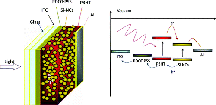| Kortshagen et al describe a hybrid photovoltaic cell that is ideally suited for inexpensive, large-scale manufacture, offers an alternate material platform that does not contain heavy metals, and delivers an incident photon-to-current efficiency (IPCE) of 1.15%. |
Reviewed by Katherine Rice, University of Colorado Boulder, Department of Chemical and Biological Engineering
While single-crystal silicon based photovoltaics are a well-developed technology, the costs associated with producing and fabricating high-purity Si limit the widespread use of photovoltaics as a renewable energy source. Recent efforts to circumvent these costs have focused on a number of developing technologies, including polymer- and nanomaterial-based solar cells. Polymer solar cells are particularly attractive because of the ease of production compared to the complex and expensive process currently used to produce traditional silicon solar cells. Polymers provide the advantage that they are flexible, inexpensive, and easy to manufacture; however, one major disadvantage is the low photon-to-power conversion efficiency of such devices. Likewise, nanocrystalline materials also show promise for solar materials because of their size-tunable optical and electronic properties as well as recently identified nanoscale phenomena such as multiple exciton generation. However, open questions over the toxicity of heavy metal-containing nanomaterials such as CdSe, PbSe or InAs remain a potential roadblock for their commercial use.

The authors report devices with an incident photon-to-current efficiency (IPCE) of 1.15%, a very good result considering that the highest efficiencies reported to date (for CdSe nanocrystal/polymer-based devices) are around 2%. The most efficient devices fabricated by Kortshagen contained approximately 35 wt % of Si nanocrystals; the use of smaller nanocrystals (between 3-5 nm in this case) were found to increase device efficiency due to the increased interfacial area between the nanocrystal and polymer matrix, and the increase of the bandgap in the Si nanocrystals due to quantum-confinement effects.
Kortshagen’s method shows that hybrid nanocrystal polymer solar cells can be easily produced from solution, potentially allowing inexpensive manufacturing techniques to be introduced, and the use of Si nanocrystals provides an alternate material platform that does not contain heavy metals. Some challenges to be addressed include difficulty in processing the solution at high weight fractions of Si nanocrystals, and a low contribution from the Si nanocrystals in the visible range. While the Si nanocrystals are useful in facilitating exciton dissociation, most of the photon absorption comes from the polymer with the Si nanocrystals only absorbing energy in the ultraviolet. Despite these few drawbacks, combining Si nanocrystals with polymer lays the foundation for future work that could make photovoltaics much more versatile and less expensive.
Image reproduced with permission from Liu CY, Holman ZC, and Kortshagen UR. 2009. Hybrid Solar Cells from P3HT and Silicon Nanocrystals. Nano Letters 9(1):449-452. Copyright 2009 American Chemical Society.
This work is licensed under a Creative Commons Attribution-NonCommercial-NoDerivs 3.0 Unported.
